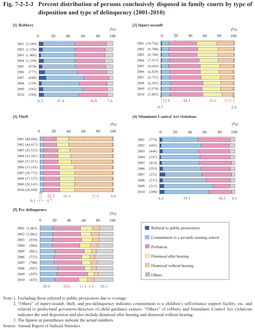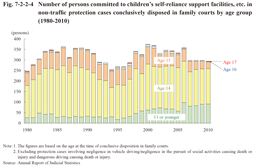2 Conclusive disposition in family courts
Fig. 7-2-2-3 shows the percent distribution of persons conclusively disposed in family courts by type of disposition and type of delinquency over the last 10 years.
Fig. 7-2-2-3 Percent distribution of persons conclusively disposed in family courts by type of disposition and type of delinquency (2001-2010)
The proportion of those committed to juvenile training schools was high for robbery and Stimulants Control Act violations (See [1] and [4] of the Fig.). With injury/assault, probation accounted for the largest number, and commitment to a juvenile training school was around 10% (See [2] of the Fig.). With theft, dismissal without or after a hearing accounted for the vast majority while probation accounted for around 20%, and commitment to a juvenile training school was around 4-5% (See [3] of the Fig.). With pre-delinquency commitment to a juvenile training school remained around 20% and probation 30-50% (See [5] of the Fig.).
Fig. 7-2-2-4 shows the number of persons committed to children's self-reliance support facilities, etc. (refers to children’s self-reliance support facilities and foster homes; hereinafter the same) for non-traffic protection cases (excluding protection cases for negligence in the pursuit of social activities causing death or injury, etc.; See Fig. 3-1-2-3) conclusively disposed in family courts by age group since 1980. The number of persons committed totaled around 300-350 every year, and with the majority of them being juveniles aged 15 or younger. The number of persons committed to children's self-reliance support facility, etc. in 2010 was roughly at the same level as that in 1993, although the number of committed juveniles aged 13 or younger increased to approximately 3.6 times that in 1993.
Fig. 7-2-2-4 Number of persons committed to children’s self-reliance support facilities, etc. in non-traffic protection cases conclusively disposed in family courts by age group (1980-2010)

